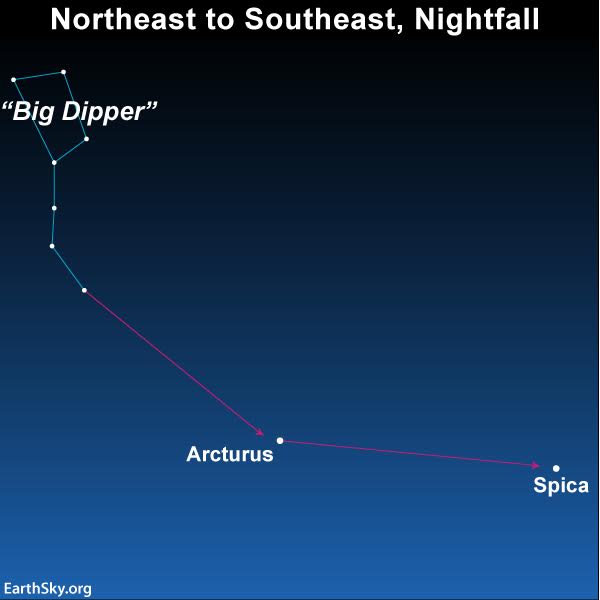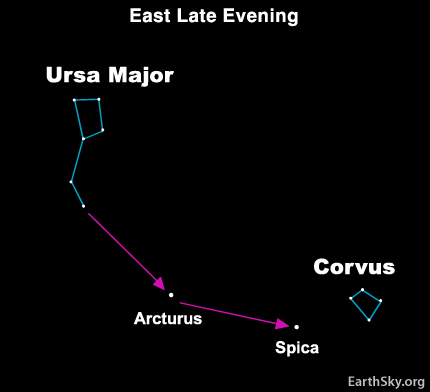
Follow the arc to Arcturus, and drive a spike to Spica. Scouts learn this phrase. Grandparents teach it to kids. It was one of the first sky tools I learned to use in astronomy.
Follow the arc to Arcturus. Find the Big Dipper asterism in the northeastern sky in the evening sky this month, maybe around 9 p.m. It’s very easy to see, a large noticeable dipper-shaped pattern in the northeast. Once you see the Big Dipper, notice that it has two parts: a bowl and a handle. Then, with your mind’s eye, draw an imaginary line following the curve in the Dipper’s handle until you come to a bright orange star: follow the arc to Arcturus.
Arcturus is the brightest star in the constellation Bootes the Herdsman. This star is known in skylore as the Bear Guard.
Modern astronomers know Arcturus as a giant star with an estimated distance of 37 light-years. It’s special because it’s not moving with the general stream of stars in the flat disk of the Milky Way galaxy. Instead, Arcturus is cutting perpendicularly through the galaxy’s disk at a tremendous rate of speed … some 93 miles (150 km) per second.
Millions of years from now this star will be lost from the view of any future inhabitants of Earth, or at least those who are earthbound and looking with the eye alone.
Drive a spike to Spica. Once you’ve followed the curve of the Big Dipper’s handle to the star Arcturus, you’re on your way to finding the bright, blue-white star Spica. Just extend that same curve on the sky’s dome.
Spica is the brightest light in Virgo the Maiden, a large, rambling constellation. The star and its constellation were sometimes associated with the Greek goddess of the harvest, Ceres. Spica is from the Latin word for ear, and the general connotation is that this star name refers to an ear of wheat, held by the goddess.
Today we know Spica as a tight double star. The two stars are indistinguishable from a single point of light via ordinary telescopes. Their dual nature was revealed only by analysis of the light from this system via a spectroscope, or instrument that splits light into its component colors. Both stars in the Spica binary system are larger and hotter than our sun. Their diameters are estimated to be 7.8 and 4 times the sun’s diameter, and, taken together, they’re more than 2,000 times brighter than the sun!
Separated by just less than 11 million miles (18 million km), Spica’s two stars orbit a common center of gravity in only four days.

On springtime evenings in the Northern Hemisphere, extend the handle of the Big Dipper to arc to Arcturus, spike Spica and slide into the constellation Corvus the Crow. We sometimes call this extended arc the spring semicircle.
Bottom line: Remember … follow the arc to Arcturus and drive a spike to Spica! Have fun.
EarthSky astronomy kits are perfect for beginners. Order today from the EarthSky store
Donate: Your support means the world to us
Source: https://earthsky.org/tonight/follow-the-arc-to-arcturus